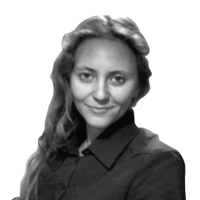
A powerful smell of hair spray lingers permanently in one of Moscow’s oldest beauty salons on Sadovo-Triumfalnaya Avenue, a few blocks from the Kremlin. The city’s female bureaucrats flock here early each morning to get their coiffures styled before a big day of meetings and hearings at the Parliament or the courts. Stout, overdressed women with heavy jewels sit statue-like and motionless as their hair is dyed, fanned, backcombed and sprayed. The most popular request: “Please do a high coiffure—a puffy one.” They emerge with huge heaps of hair glistening like shining armor.
To Westerners, the big hair trend brings back somewhat unfortunate memories of the‘80’s. But to ordinary Russians, the style is associated with an “important” woman who has reached a respectful age. The look is normally accessorized with large and expensive gemstone earrings, long nails, and broad-shouldered jackets. “No matter how hard we try to get our clients to change their old-fashioned hairstyle for a more natural look, nothing sounds better to them than helmet hair—something they believe looks solid and impressive,” says Larisa Bolotova, a hairdresser with 25 years of experience building “massive mountains” of tresses on women’s heads.
The hairstyle has been popular in Russia since the days of the Communist Party. Perestroika and glasnost may have come and gone, but the hair has remained the same. Now, the most avid enthusiasts hail from Vladimir Putin’s ruling United Russia party, and hairdressers say the women are ever willing to “spend an hour and a half on the favorite hair style.”
Some looks make a stronger impression than others. Recently, a former Russian deputy prime minister took to Facebook to critique portraits of United Russia deputies Nina Baranova and Valentina Petrenko. (Both of the women boast impressively shellacked do’s.) The former politician, a businessman named Alfred Kokh, complained, “If they have that outside of their head, what is inside? And these people make our laws!” His post inspired over 600 ‘likes’ and dozens of comments, including one that joked, “The Face of our Parliament is not as scary as its hair.”
The cyber-bullying of the female politicians came on the heels of a powerful victory by United Russia candidates at regional elections last weekend.
The trend goes all the way up the chain of power to First Lady Lyudmila Putina herself. Glamorous Muscovites have made a sport out of dissecting her appearance at public outings, which are increasingly rare these days. “I once happened to be at the same expensive hairdressing salon with Putina,” says Miroslava Duma, a celebrity fashion consultant and Russian It-girl, whose street style has become an inspiration to the country’s young women. “As soon as the professionals finished working on her healthy, thick hair, Mrs. Putina came to the mirror and remodeled her hair the way she liked, brushing most of it to one side.”
“It is unclear why our top female officials feel reluctant to ask professional designers or stylists for a piece of advice,” says Duma, who adds that both Putina and Svetlana Medvedeva, wife of prime minister Dmitry Medvedev, have final say over their own outfits, even though they employ personal designers. “I have tried to suggest to some of them that designers are necessary, like dentists, but in vain.”
While tracking the runway trends is popular among younger Russians, fashion designers have not been able to crack the Kremlin. Putina is known for rejecting the suggestions of her designer Igor Chapurin, who would like to put her in slimming black. (Putina prefers lighter colors and multicolored prints.)
Square, big-shouldered suits are another style that Russia’s ruling elite seem to love. Medvedeva sported a white blazer with linebacker shoulders when she appeared with Michelle Obama during a visit to Washington D.C. in 2010.
“Unconsciously, [these] powerful ladies create a solemn, formidable and imposing uniform to be recognized by their own kind,” says Moscow poet Lev Rubinstein, who notes that the fashion statement is also adopted by female school directors or women in Communist presidiums. “Just the way city hipsters are keen on wearing narrow, tight pants or colorful sneakers, official women produce what in their imagination should be seen as a serious and important uniform for a person with authority.”
Others see the style as a self-defensive move. “By constructing back-combed masterpieces on their heads and by wearing square suits, [political] women tend to look less feminine, or maybe less vulnerable,” agrees ballerina Anastasia Volochkova, a former United Russia member. “[But ]sometimes, gentle feminine hearts beat under those ridiculous rough jackets.”






